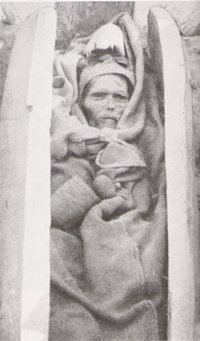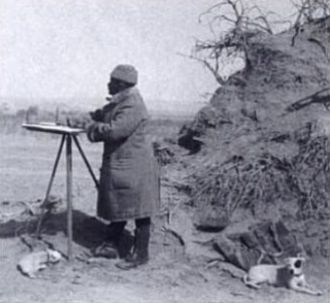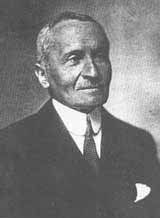On the Trail of the Danes - In Asia
9. Tarim Basin I
In the ancient Icelandic document, "Edda" of Snorre Sturlason, in the part called "Gylfaginning", is told about the Earth: "Then Gangleri spoke:" - "This is great news, I now hear. It is a great craftwork and cleverly done. How was the Earth conceived?"
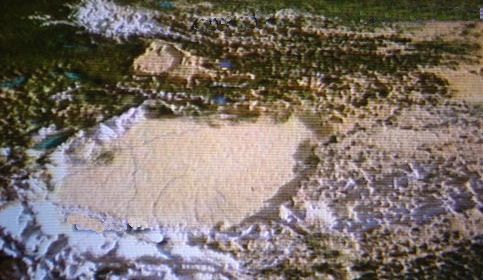
Map showing Tarim Basin.
Then Har answered: "She is ring-shaped on the outside, and all around her is the deep ocean, and along this sea-beach, they gave the land to settlements for the Jotuns, and their descents. But on the inside Earth they made a fortress around their homes against the hostility of the Jotuns, and as their castle, they had the eyebrows of the original Giant, Hrymer, and they called this castle Midgaard".
Tarim Basin in Xin Jiang is a good candidate for Midgaard. It is surrounded by huge mountain ranges as high as the Alps, and it is shaped like an enormous eye. One can travel from Kashgar, the Western corner of the eye, along the northern Tian Shan Mountains, which route is the northern branch of the Silk Road. Or, one can travel along the southern Kunlun Mountains, the southern branch of the Silk Road, and both routes lead to the city of Dun Huang, the eastern eye corner. In the middle lies the fiery desert, Taklamakan.
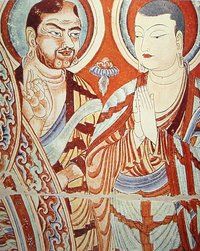
Cave painting from Turfan in the Xin Jiang province showing two buddist monks one European type and one Chinese type.
Even when you do not have a possibility to see the land from space, one can easily imagine, that it resembles a huge eye, the desert is the pupil and the coloured part of the eye, and the huge mountain ranges are the eyebrows.
In the history of civilizations, there are several examples that the original home, or point of departures for a civilization, is a rather limited area divided into many small states and areas that are fiercely rivaling each other, while the areas over which civilization spread are far greater than the indigenous states. Thus, there were about 600 small cities in ancient Greece, while the areas to which their civilization spread were much larger, for example Sicily and southern Italy, not to mention the Empire of Alexander the Great. On a global scale, Europe is of limited size and divided into a host of smaller states that have waged many wars among themselves, but the areas to which the European civilization spread are far larger. Just think of the US, Sirbiria, Canada, Brazil and many other areas.
Left: Stein found the first mummies of caucasian type in Tarim Basin.
Mid: Stein and his dog Dash, who followed him everywhere.
Right: Sir Aurel Stein 1862-1943.
The Tarim Basin was also such an area of very limited size divided into a host of rival small states.
A Chinese document from the Han Dynasty, "Hou Han Shu", describes Central Asia west of China in the first few centuries AC. It sums up 36 kingdoms, most in the Tarim Basin and the rest of the present Chinese province Xin Jiang, but also some west of the Pamirs. The area was later divided into 55 kingdoms, it is told.
Another Chinese source says, that there were 40 kingdoms. But probably none of the numbers are right, or to put it another way: There were eternal conflict and struggle between the kingdoms, some were defeated by their neighbours while others rebelled for independence, nothing was static.
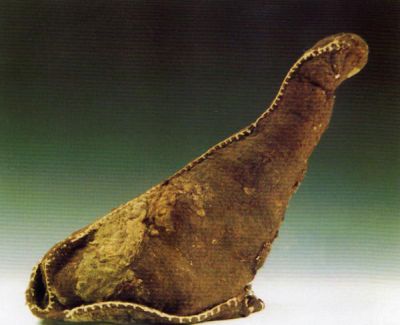
A two-thousand-year-old felt hat found in Tarim Basin.
It is tempting to believe that Tarim Basin was such an original area that has been the birthplace and point of departure - a Midgaard - for many civilizations, perhaps originally a refuge for humanity through the last Ice Age, just as the caves of southern France and Spain were in Europe.
There are many ideas on an Indo-European original home but Tarim Basin is definitely one of them. In that case, the rainbow bridge, "Bifrost", between Midgaard and Asgaard must have been somewhere on the crossing over a Pamir Pass. A place where the trail crosses a river with a strong current, creating water droplets in the air and thus a constant rainbow.
The Hungarian-born, English explorer sire Aurel Stein (1862-1943) arrived in Dun Huang in northern Gansu for the first time at the beginning of the last century, about 1903. He found an old defence wall, which stretched from the foot of the mountains near Dun Huang to "Kara Hotho," "The Black Castle", near the present Mongolian border. He spent some days to explore it. It was built just at the beginning of the first millennium.
"Hou Han Shu" tells, that the king of Suoche, who had the name Xian, wiped out several kingdoms, but after his death, they started fighting among themselves. Xiao, Yuan, Junggjue, Rong Lu and Qiemo were conquered by Shan Shan. Qule and Pishan were conquered by Yutian (Jy-tian). Yuli, Dan Huan (Dan Hwuan(g)) and Guhu were wiped out by Ju-chi. The beleaguered small states sent deputations to the Han court and asked for Chinese military to protect them against their neighbouring states. But when they got tired of the Chinese, they rebelled against them and instead made treaties with the Xiong-Nu. But because the Xiong Nu charged too much in taxes, they returned to the Chinese. The joker in the political game was the northern Xiong-Nu, "The Northern Savages", hated by everyone, including the Southern Xiong-Nu.
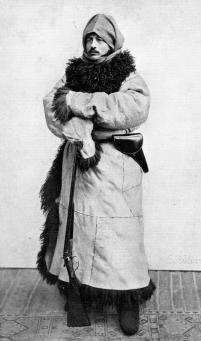
The Swedish explorer Sven Hedin.
The Han Dynasty Emperors had a very strong motivation for opening the route to the west. They needed horses for their wars against the Xiong Nu.
The traditional Chinese horses were of very poor quality. But the horses they bought from the Yuezhi (Yuch Chi) people in the Fergana Valley were excellent, and they became the key to victory. They were the heavenly horses, the horses sweating blood. Maintaining the line for stable supplies of these horses were the main reason for their presence in the Tarim Basin. It is said, that this was the beginning of the Silk Road.
The kingdoms in "the Western Regions" converted to Buddhism very early and became Buddhist strongholds. After their conversion, they followed the Buddhist doctrine of not killing and not wage war. They believed in Buddhism with great inner strength and sincerity. The thousands of Buddhist cave paintings give evidence of their strong faith.
The Buddhist monk Fa-xian traveled through the oasis towns around 400 AC. He wrote: "Every kingdom has thousands of monks, and each kingdom spoke their own barbaric language."
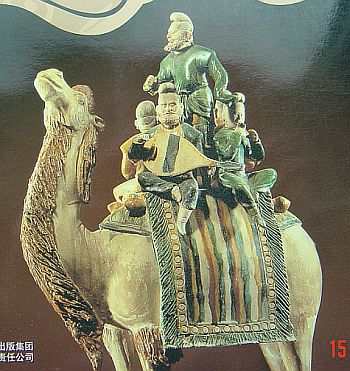
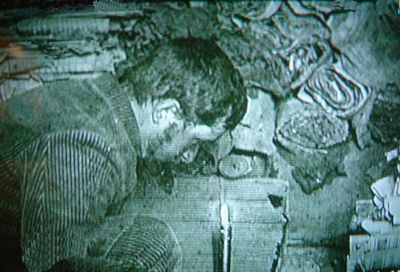
|
Left: Musicians on camel - found in the tomb of Xianyu Tinghui near Xian 1957- Tang Dynasty dated 723 AC. Some of the musicians seem to have blond hair and beard.- The National Museum of Chinese History.
Right: The French Explorer Pelliot between the old documents in the caves at Dun Huang.
Musicians and dancers from the towns in the Tarim Basin were very famous at the Tang court in China. The Chinese-Japanese Silk Road Expedition was the first to travel into the area after its opening in 1980. They identified a dozen different stringed instruments on the Buddhist cave paintings. They thought that some were brought to Japan with Buddhism.
The early explorers Przhevalskii, Stein, Le Coq, Pelliot, Kozlov and others collected a lot of old documents, that had been preserved for more than thousand years in the extremely dry climate. Some were written in a hitherto unknown language, which is called Tocharian. It proved to be an Indo-European language with similarities mainly to German and Celtic languages, it is said. It was found in two variants Tokharian A and B. We remember, that the Buddhist monk Fa-xian told, that "every city spoke their own barbaric language".
Tocharian must have been the general language of Midgaard, probably in many different variations and dialects. It could be such a language that the Asians brought with them to Scandinavia.
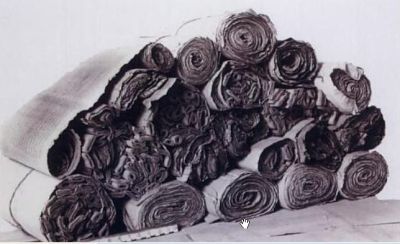
Some of the Dun-Huang document rolls.
The Buddhist monk Xuan-zang told about the city of Kucha in 645 AC: "The earth is good for rice and corn, they grow grapes, pears, and many kinds of peaches and almonds. The soil is rich in minerals, gold, copper, iron, lead and tin. The air is pleasant, and the people's attitude is honest. There are 100 monasteries with 5,000 or more disciples." The oasis towns appeared to be very rich, and they had thrown enormous resources into the religion. They must have seemed very tempting to the surrounding nomads.
One by one the Kingdoms in the Tarim Basin were taken over by the Tibetans and Chinese. Later came the Hepthalites, the White Huns, then came the Western Turks and the Liao Tatars. In the Middle Age came the Mongolian-Turkish armies led by Djengis Khan. The great Khan allowed the Turkish Uigurs to settle in the area as a military reserve. That is why they insist on calling it the "East Turkestan". Finally came the Chinese.
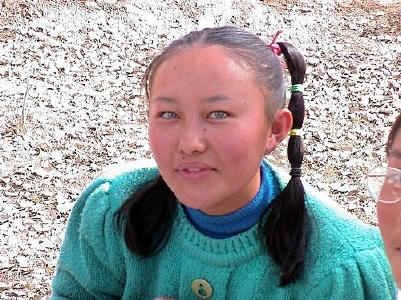
Girl from Xin Jiang with blue eyes. Foto Chinese History Forum.
But there is still a relatively high frequency of blue eyes and light hair in Xin Jiang, higher than in the rest of China. Often, when a television channel is broadcasting from there, the camera swings around and shows a little blond girl or boy.
In modern times we have witnessed the final end of another Buddhist State, Tibet, which was absorbed by China. Perhaps the Buddhist kingdoms in the ancient Midgaard have vanished in very much the same way. All resources were thrown into the religion. Each family sent a young man to the monasteries, whom society as a whole should support.
20200629



